Black snakes (Pseudechis spp.)
This genus includes the large Mulga or King Brown snake (Pseudechis australis) and the red-bellied black snake (P. porphyriacus), as well as Collett's snake (P. colletti), the blue-bellied black snake (P. guttatus) and the Papuan black snake (P. papuanis).
Mulga snake (King Brown Snake) (Pseudechis australis)
About
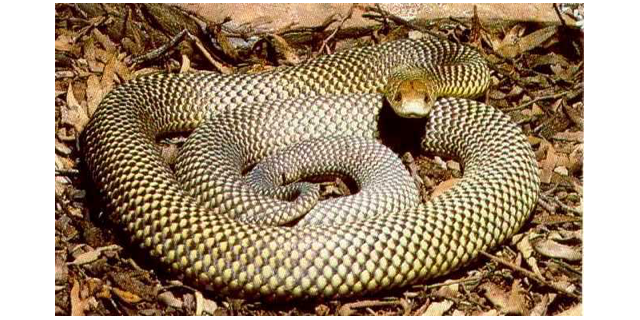
(Photo P. Mirtschin)
The Mulga snake has the largest recorded venom output of any snake. The name "King Brown" snake may lead to confusion and to the incorrect use of brown snake antivenom, and is therefore best avoided. It feeds on rats, mice birds, lizards and other snakes. It is frequently active at night, especially in hot weather. It is heavily built, being in fact the heaviest Australian venomous snake. The body is uniform in colour, usually light brown, but there is some variation between individuals. The average length is around 1.5m, and the record length greater than 3m. Mulga snakes are oviparous (egg-laying). They may become aggressive and strike repeatedly if threatened.
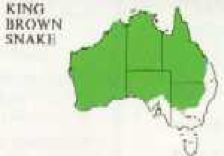
Distribution
It is found throughout Australia, except in Victoria, Tasmania and the most southern parts of Western Australia.
Venom
Average venom yield is around 180mg, with a maximum of 600mg recorded from a single milking. The venom is somewhat less toxic than that of many other Australian venomous snakes. Myotoxicity is a major feature, and the venom also contains, procoagulants and possibly neurotoxins. Swelling and pain at the bite site maybe seen, and are unusual in bites by other Australian snake genera. Black snake antivenom should be used for envenomation by the Mulga or the Papuan black snake.
Red-bellied black snake (Pseudechis porphyriacus)
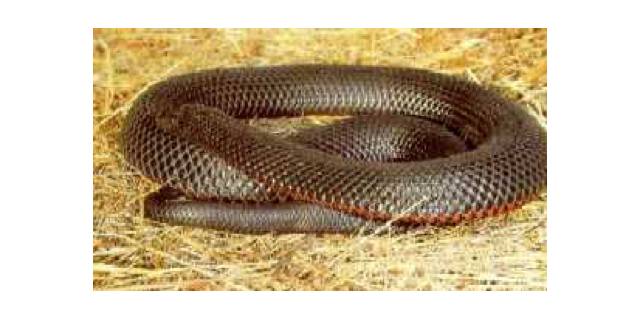
(Photo P.Mirtschin, Venom Supplies)
About
Also called the common black snake. The red-bellied black snake prefers swampy, moist areas around creeks, rivers and lakes. They prey on rats, mice, frogs, lizards and birds, as well as fish and eels, as they are good swimmers. They also eat other snakes, including those of their own species. Red-bellied black snakes are mostly active during the day, and are not particularly aggressive.. When threatened, they will flatten their bodies and hiss loudly, but will usually attempt to escape if possible. Red-bellied black snakes are usually black or dark grey in colour, with red or orange flanks. The average length is 1.25m, and the maximum recorded length is 2.5m. The young, numbering from 12-20, are born alive.
Distribution

Distribution
Distributed down the east coast of Australia, not including Tasmania, and slightly into South Australia
Venom
The red-bellied black snake, while still dangerous, is somewhat less venomous than many other Australian snakes. Average venom yield is around 37mg, and the maximum recorded is 94mg. Its bite may cause coagulopathy, neurotoxicity and myolysis. No deaths have been confirmed in adults, although children have died after bites by this snake. Black snake or tiger snake antivenom may be used, and the latter is preferred due to the smaller volume of protein solution required.
Spotted Black snake (Blue-bellied black snake) (Pseudechis guttatus)
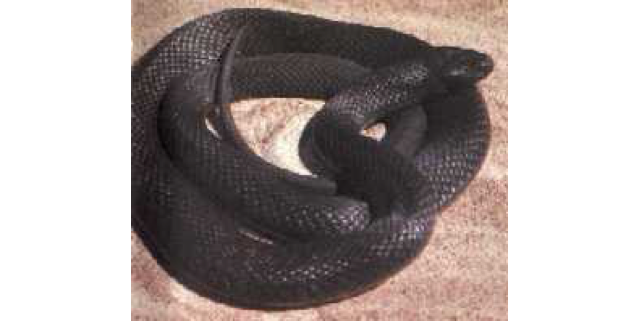
(Photo G. Gow)
About
This lesser-known snake is shy, and avoids contact with humans. It prefers drier inland areas.
The body is a dark glossy black, with or without cream spots. The head is slightly distinct from the neck. average length is around 1.25m, maximum length 2m. They are oviparous (egg-laying). When threatened, the blue-bellied black snake flattens its body and emits a loud whistling hiss.
Distribution
Found in south-eastern Queensland and northern New South Wales.
Venom
Average venom output of this snake is unknown. The toxicity (in mice) of blue-bellied black snake venom is the highest of any of the black snakes. Bites are infrequent, and may cause severe local pain and regional lymphadenpathy. Tiger snake antivenom is the treatment of choice.
Collett's Snake (Pseudechis colletti)
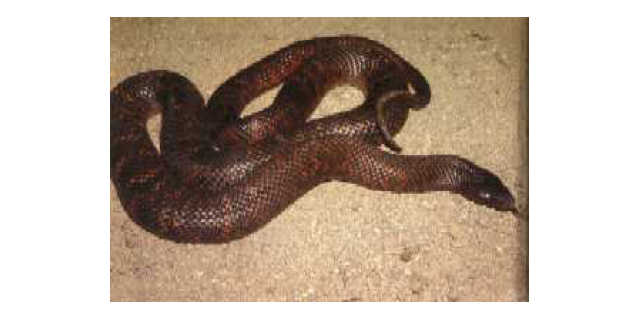
(Photo G. Gow)
About
This attractive snake lives inland, in dry areas, hunting by day and feeding mainly on lizards, snakes and other small animals. It is solidly built, with a slightly distinct head, and is beautifully marked, with scales of varying colours of orange to dark brown, producing a speckled effect. The average length is 1.25m, and the maximum recorded length 2m. Eggs are laid, usually numbering around 12.
Distribution
Limited to central Queensland, but is kept in many snake collections.
Venom
The toxicity of Collett's snake venom is similar to that of the Mulga snake. Average venom output is unknown. Tiger snake antivenom should be used to treat envenomations.
Papuan Black snake (Pseudechis papuanis)
About
A member of the black snake group found in Papua New Guinea, this snake's numbers are thought to be in decline, possibly as a result of the introduction of the cane toad (Bufo marinus) into its habitat. It lives in swampy areas of the southern coastal lowlands of PNG, where it feeds on small mammals and frogs.
It is usually a uniform glossy black, but may be dark brown. It is solidly built, with a large, flat head. The length ranges from 2.1 to 2.4m. It is oviparous.
The papuan black snake is said to be of a nervous disposition, avoiding human contact, but will strike aggressively if cornered.
Distribution
Papua New Guinea
Venom
Average venom yield is around 200mg, maximum 494mg. The venom produces coagulopathy, neurotoxicity and haemolysis. The antivenom of choice is black snake antivenom.